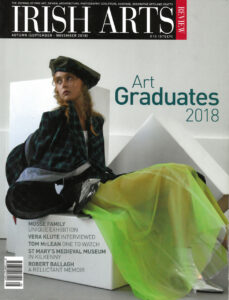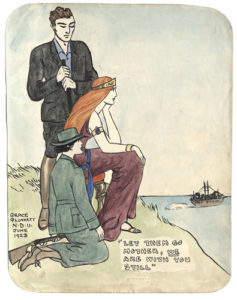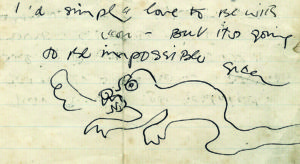

Christian Dupont reflects on the personal and political desires conveyed in two cartoons by Grace Gifford Plunkett

1 GRACE GIFFORD PLUNKETT (1866-1953) watercolour drawing in anonymous album of female prisoner autographs, 1915-23 21.5×17.5cm Provenance: Loretta Clarke Murray, 2016
William Orpen posed his promising student Grace Gifford as a model for his Young Ireland series and the biblical Ruth, but more typically, she has been memorialized as the tragic bride of Joseph Mary Plunkett, whom she married hours before his execution in Kilmainham Gaol for his role in the Easter Rising. She was, or rather became, an activist and artist in her own right, combining both propensities in her clever and widely circulated cartoons. Hilary Pyle paid her fitting tribute in the Irish Arts Review Summer 2014 edition. Recent rediscoveries and acquisitions by Boston College’s Burns Library provide additional sources for appreciating Gifford’s canny character and caricatures.
During the 50th anniversary of the Rising, the Belfast News Letter published a photo and story of a letter that the journalist estimated was Gifford’s last surviving message to her fiancé, written two days before the GPO takeover.
‘I’d simply love to be with you – but it’s going to be impossible’, she concluded, adding a sketch of a ravenous dragon to the bottom of her note. As simple and animated as Picasso’s line drawings of doves, the doodle recalls a poem Plunkett wrote to her two weeks prior: ‘The joy of Spring leaps from your eyes / The strength of dragons in your hair’.
Heirs donated most of the Plunketts’ correspondence to the National Library, but through an odd series of events, this letter wound up in the hands of a bystander during the Easter Week tumult and had remained in private possession since.
The joy of Spring leaps from your eyes
The strength of dragons in your hair

2 GRACE GIFFORD PLUNKETT detail of letter to Joseph Mary Plunkett, 22 April 1916 20×15.6cm Provenance: De B√∫rca Rare Books, 2017
Following an appointment to the Sinn Féin executive in October 1917, Gifford increasingly applied her skills as an illustrator for newspapers and journals to creating propaganda for nationalist, labor, and suffrage causes. An Anti-Treaty protestor during the Civil War, she was arrested and imprisoned in Kilmainham Gaol along with some 400 other women. On the walls of her cell, she painted an image of the Madonna and Child, later celebrated and restored in the 1960s by future RHA president Thomas Ryan.
A recently acquired album containing autographs, verse, and drawings by approximately 120 women prisoners includes a watercolour cartoon created by Gifford in June 1923, following her transfer from Kilmainham to the North Dublin Union. A woman with a flowing mulberry gown and golden crown emblazoned ‘Eire’ encircling her amber tresses is seated on a bluff, looking grimly across the Irish Sea as a merchant ship with ‘Free State’ lettered along its gunwale sails away. A Cumann na mBan volunteer kneels to her right, mirroring her vacant gaze, while a man in dark civilian clothing looks upon them pensively and sympathetically. A caption pleads: ‘Let them go mother, we are with you still.’ Gifford’s Young Ireland hearkened back to Thomas Davis’, not Orpen’s.
This is the sixth in a series of articles on Burns Library and its collections that attempts to provide context for appreciating the work of Irish artists and their reception in America.
Christian Dupont is Burns Librarian and Associate University Librarian for Special Collections at Boston College, Boston USA.



